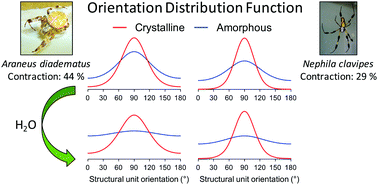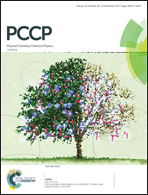A quantitative analysis of the supercontraction-induced molecular disorientation of major ampullate spider silk†
Abstract
Spider silks exhibit remarkable properties, among which the so-called supercontraction, a physical phenomenon by which fibers undergo a longitudinal shrinkage and a radial swelling when exposed to water. The process is marked by a significant decrease in chain orientation resulting from plasticisation of the amorphous phase. Despite several studies that determined the Hermans orientation function, more quantitative data are required to be able to describe theoretically the macroscopic water-induced shrinkage from molecular reorganization. Here, we have examined the supercontraction of the major ampullate silk single fibers of Nephila clavipes (Nc) and Araneus diadematus (Ad) using polarized Raman spectromicroscopy. We determined the order parameters, the orientation distribution and the secondary structure content. Our data suggest that supercontraction induces a slight increase in β-sheet content, consistently with previous works. The β-sheet orientation is slightly affected by supercontraction compared to that of the amorphous phase, which becomes almost isotropic with shrinkage. Despite an initially lower orientation level, the Ad fiber shows a larger orientation decrease than Nc, consistently with its higher shrinkage amplitude. Although they share similar trends, absolute values of the orientation parameters from this work differ from those found in the literature. We took advantage of having determined the distribution of orientation to estimate the amplitude of shrinkage from changes in macromolecular size resulting from molecular disorientation. Our calculations show that more realistic models are needed to correlate molecular reorientation/refolding to macroscopic shrinkage. This work also underlines that more accurate data relative to molecular orientation are necessary.



 Please wait while we load your content...
Please wait while we load your content...